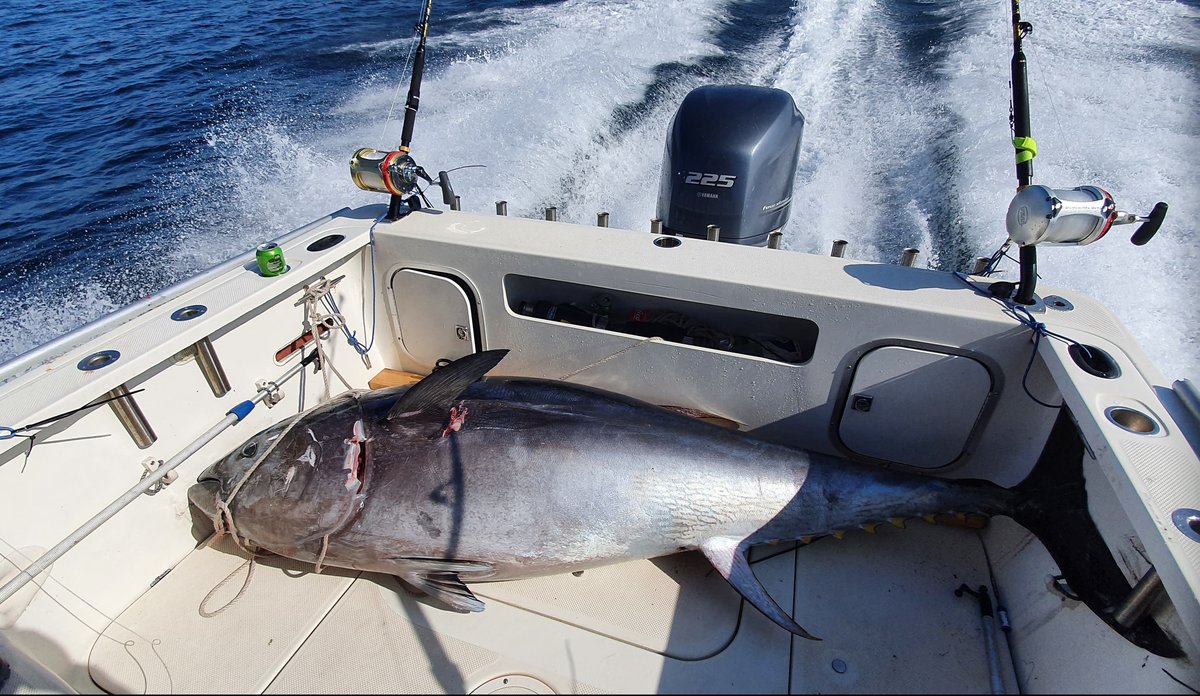Norwegian rod-and-reel fishery for Atlantic bluefin tuna is underway

The first tuna was caught by Team Blega Southern Tuna in Skagerrak after a great effort by the whole crew. The team decided to land the fish, which means they have used up their recreational fishing quota.
Photo: Jarle Olsen / Team Blega Southern Tuna
The tuna was caught on a so-called spreader bar – a school of rubber squid pulled behind the boat. One stands out as a stinger.
Photo: Jarle Olsen / Team Blega Southern TunaPublished: 18.08.2020 Updated: 26.08.2020
The bluefin tuna population has increased significantly after strict fishing limits were imposed. The world's biggest tuna is back in Norwegian waters, ploughing its way along the coast at high speed in search of the abundant prey.
The total Norwegian bluefin tuna quota for 2020 is 312 tonnes. One tonne has been set aside for tag and release fishing, and five tonnes for a historic recreational fishery (see fact box).
Learn about growth and migration
“18 of the boats are participating in the tag and release fishing. The anglers insert a so-called spaghetti tag into the fish. That is a basic plastic tag with an identification number that provides us with valuable information if the fish is subsequently recaptured”, explains marine scientist and tagging expert Keno Ferter.
“Basically, this tells us how much the fish has grown and where it has swum since last time. Research and a better understanding of the species have been vital to the recovery of the bluefin tuna”, he says.
The fishery is organised by the Directorate of Fisheries, while the IMR organises the tagging and helps with training, supervising and approving crews.
Fillets also go to research
The anglers are also allowed to land one bluefin tuna per boat for their own dinner tables. This is the first time in recent history that the authorities are allowing recreational fishers to target and harvest the species.
“From these fish, we get unique samples from all parts of the fillet. Then researchers analyse the levels of contaminants, such as dioxins and mercury, in the meat”, explains Ferter.

It is the first time that the IMR will get hold of so many and extensive samples from the parts of the fish that are normally eaten. This is because bluefin tuna caught by the commercial fishing fleet are sold headless, but otherwise whole. The price they fetch depends on the quality and appearance of the fish.
“We cannot dissect the fillets from the commercial catch, but we always analyse their DNA and obtain their age from the fins and head”, explains Ferter.
The historic landing of a rod-and-reel caught bluefin tuna – followed by another one
At the weekend, Team Blega Southern Tuna landed the first recreationally caught bluefin tuna in recent times. The fish was 244 cm long. On Monday, Team TechnoTroll copied their feat with a 251 cm-long tuna. Both fish had an estimated weight of over 200 kilos.
The first bluefin tuna was caught 30 nautical miles off Fevik in Skagerrak. The second one was also caught in Skagerrak. By then, both teams had already been fishing for a few days and had had many sightings.
“The third source of data from the recreational fishery is bucket-loads of observations, which we're delighted to get”, says Keno Ferter.
“Soon 24 small boats will be out along large parts of the Norwegian coast scanning for bluefin tuna with eagle eyes. Their observations tell us about the migration, numbers and distribution of the fish”, he continues.
Five pop-up satellite tags in reserve
The researchers are continuously monitoring the fisher's observations and catches. That is because they have gotten five pop-up satellite tags from the International Commission for the Conservation of Atlantic Tunas which they hope to use. But they have to do that job themselves.
“These are expensive, high-tech tags that are attached to the tuna and act as data loggers. After a specified time they release themselves, float to the surface and transmit the details of their journey back to base”, explains Ferter.
The tags have to be fixed carefully and well to the fish, and in addition the fish must be able to continue on its way in perfect shape. That requires special equipment and expertise.
“We're continuously assessing whether to rush off to follow a team with our tagging boat”, he concludes.
(Updated 21.08.: A third fish is captured - tagged and released in Ålesund by Team Big1)
